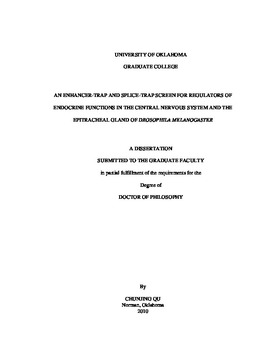| dc.description.abstract | Peptide hormones play important roles in a wide variety of biological processes, such as learning and memory, body weight homeostasis, circadian rhythms, and addiction. In Drosophila, over 20 peptide hormones are produced in the central nervous system (CNS) by distinct groups of specialized neurons, peptidergic neurons. Another important endocrine function is performed by the Inka cell, responsible for the production and secretion of the ecdysis triggering hormone (ETH), which is critical for the ecdysis process of the animal. Although many genes encoding peptide hormones have been identified, our knowledge about factors that regulate the production and secretion of peptide hormones is still very limited. In order to identify more endocrine regulators, we performed an enhancer trap and splice trap screen for genes that are expressed in peptidergic neurons in the CNS and the epitracheal gland, where the ETH-expressing Inka cell is located. From a screen of 545 splice trap lines and 287 enhancer trap lines, we obtained 28 insertions in 25 genes that are expressed in peptidergic neurons of the CNS, and 14 insertions in 14 genes that are expressed in the epitracheal gland. For lines that are expressed in the CNS, we further mapped the expression patterns by immunostaining with antisera to several neuropeptides, including Bursicon, Drosophila insulin-like peptide 2, crustacean cardioactive peptide, and leucokinin, each of which is expressed in distinct groups of neurons. Among the 28 lines identified, the BG00836 insertion in the gene alan shepard (shep) was extremely interesting to us because of its restricted reporter gene expression in peptidergic neurons. shepBG00836 mutant adults showed defects in wing expansion and decreased resistance to starvation, and these phenotypes were reverted by precise excision of the P element. However, it was later shown that these may be neomorphic phenotypes brought by the combination of the shep mutation and unknown factors in the genetic background. Follow-up experiments on shep showed that it is involved in the control of neurite outgrowth in the CNS. Therefore, shep may function as a general developmental regulator for peptidergic neurons. Lines with reporter gene expression in the epitracheal glands may reveal genes that participate in the regulation of ETH expression or secretion. We examined the functions of the trapped loci by knocking down gene expression specifically in the Inka cells with transgenic RNA interference (RNAi). Expression of UAS-taiman (tai)RNAi in the Inka cells led to ecdysis defects and reduced ETH expression. TAI is a known ecdysone receptor coactivator, and expression levels of TAI were correlated with the circulating steroid hormone titer. Previous research results in our lab and the Cherbas lab suggested that the basic-leucine zipper transcription factor Cryptocephal (CRC) and the EcR/USP heterodimeric ecdysone receptor together form a complex on the ETH promoter and activate the expression of ETH. Based on these findings, we propose a model in which a complex of TAI, CRC, and EcR/USP binds to the ETH promoter and activates ETH transcription. | |
